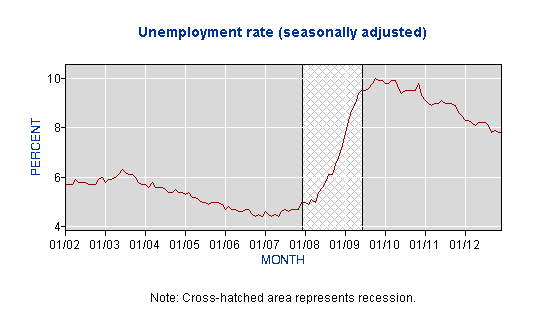Woot! Woot! The U.S. unemployment rate is holding steady at 7.8%. Time to break out the champagne, right?
Not really. There are still 20 some million unemployed or underemployed people (depending upon whose definition of “underemployed” you use). Add to that 88 million who have dropped out of the workforce entirely, and you come up with a total of approximately 110 million workers who are unemployed, underemployed, or who have simply given up hope of ever finding a job.
That’s 35% of the American population—people whom the Bureau of Labor Statistics classifies as “functionally unemployed.” According to Gallup’s Payroll to Population indicator, only 45% of Americans over age 18 years of age have full-time jobs!
In light of such sobering statistics, you might want to rethink the celebratory bubbly and instead, pour yourself a good stiff drink.

Corporate Culpa
So what’s to blame for the unprecedented jobless rates we’re seeing today? Outsourcing, a supposed jobs deficit and the Great Recession are atop the minds of many. But if you bring the unemployment crisis down to a more personal level, employers deserve the lion’s share of the blame.
When it comes to filling open positions, companies set themselves and applicants up for failure by using outdated, ineffective (and often unfair) methods to recruit and hire. Simply put, most employers operate outside the realm of common sense.
Recruitment and assessment of prospective hires is generally based on a match system. In other words, applicants are screened according to how closely their background matches the job description. The goal: find the “perfect match.” In theory, this type of system makes sense; in the real world, not so much. Filtering applicants according to a perfect match instead of potential to do the job, excludes a great number of viable candidates. Take the case of my friend James:
- A commercial copywriter and editor for over 15 years. James has written websites, books, magazine articles—you name it. When he was laid off, James registered with a temp agency, thinking it would be a good way to generate income and network while he pursued another full-time position. A national pet care company posted an opening for a direct mail editor. “Direct mail” as in the ad circulars delivered daily to everyone’s mailbox and immediately discarded. Thinking he was a good fit, James applied, only to be turned down because the company was looking for “someone with experience editing price points.” What? Ironically, the rejection e-mail (which the temp agency forwarded to him) was full of grammar/spelling mistakes.
It just goes to show—you can’t fix stupid. Every day, applicants are summarily excluded from consideration because companies continue to focus on how well a candidate matches the job ad description when instead, the focus should be on the candidate’s ability to do the job.
Unfair Hiring Practices
Many companies won’t even consider applicants that fail to list a salary requirement—a practice that screams cheap and leads job seekers to think that the company will lowball them. Companies ask about salary up front because they don’t want to waste their time interviewing candidates who are out of their price range. That’s perfectly legitimate, but the right way to handle this sticky issue is for the employer to state the salary range, either in the ad or during the initial contact with the applicant.
Here’s another disturbing trend. In an attempt to maintain profit margins, some employers are going down the “two for one” road. That’s where the company combines two jobs, advertises for one position (with all the responsibilities of both), and offers a salary that’s roughly half of the newly repackaged job that was more junior. This is an outrageous practice reminiscent of feudal lords and vassals. Unfortunately, many employers have been quick to capitalize on the unemployment crisis by demanding more and paying less.
Midlife Mayhem
Midlife workers face some of the steepest odds of any job seekers in this economy. Why? Age bias has a lot to do with it. It’s no secret that workers over age 45 aren’t considered a target group for employment. Younger applicants are perceived as being more flexible; more technologically savvy; a better deal in terms of salary and benefits. Further, midlife workers who lost their jobs as a result of corporate downsizing are often perceived as being second rate, or somehow at fault for being unemployed. Misperceptions regarding older workers are both ridiculous and reprehensible.
The ugly truth is that midlife workers have been delivered a double blow. Not only have they lost their jobs—they’ve lost their employability. Millions of lives are falling apart because experienced professionals can’t get hired. Savings are gone, homes are lost and hope is tenuous, at best.
Employers have been slow to recognize the value in hiring midlife workers, despite numerous studies showing that older workers generally have superior interpersonal skills, less absenteeism and a lower turnover rate than their younger counterparts. And although forward-thinking companies such as German automaker BMW and L.L. Bean (to name a few) go out of their way to recruit older workers, far too many do not.
Tackling the unemployment crisis requires a multi-faceted, bold approach—and it starts with employers. Companies need to start using their heads when hiring. Stop looking for the “perfect” match. Work toward streamlining the hiring process. Stop overlooking an entire generation and start celebrating the unique skills and experience midlife workers bring to the job. It’s time to put the “human” back into Human Resources—and get people back to work.
 Lisa Strickland is the founder of Operation Boomerang, a nonprofit organization focused on helping out of work and underemployed baby boomers make a comeback. The organization partners with companies to develop business-oriented solutions to employee recruitment and offers relief in the form of goods/services to baby boomers hard hit by the Great Recession. Contact her at [email protected].
Lisa Strickland is the founder of Operation Boomerang, a nonprofit organization focused on helping out of work and underemployed baby boomers make a comeback. The organization partners with companies to develop business-oriented solutions to employee recruitment and offers relief in the form of goods/services to baby boomers hard hit by the Great Recession. Contact her at [email protected].
Photo Credit BLS





